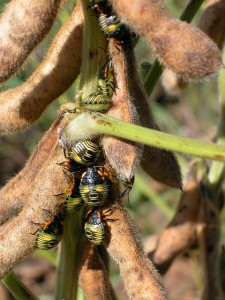Surely we are done worrying about insect pests! Well that is the case for cotton as any spraying at this late date would be akin to chasing the pot at the end of a rainbow. However, don’t let one week of fall-like temperatures fool you. Late maturing soybean fields will be a sink for insect pests as other crops mature. It is very important to scout soybean fields weekly until at least R6 (full seed).

Stink bugs pressure has been light most of the year, but I am finally getting a few calls about infestations that require treatment. Remember, the suggested stink bug threshold is 36 bugs per 100 sweeps. Treatment may be required anytime up to R7. However, if fields are well below threshold at R6, it is unlikely that stink bugs will cause significant yield loss before the crop matures. Insecticide treatments for stink bugs between R6-R7 will affect seed quality more than yield. Consider relaxing the treatment threshold after R6, and by R7, I would not treat for stink bugs unless population are twice the above threshold. Synthetic pyrethroids such as Baythroid XL, Brigade, Declare, Fanfare, Karate or Warrior II and Mustang Max should do a good job of controlling green stink bugs. Consider using higher labeled rates or one of the bifenthrin products at 5 oz/acre (e.g., Brigade, Discipline, Fanfare, Sniper, etc.) if many brown stink bugs are present.
Soybean loopers are the other common pest of late maturing soybean fields, but cabbage loopers may also be part of the complex. Both have two pair of prolegs (pictured below). Soybean loopers often but not always have black true legs and/or black spots on the body. Cabbage loopers do not. There are reports of some soybean loopers, but I am not aware of any populations at treatment level. The cooler weather should help because loopers tend to struggle under these conditions. Treat for soybean loopers anytime between R1 – R6 when defoliation exceeds 20%. An alternative threshold is to treat when populations exceed an average of 19 larvae per 25 sweeps. Because plants become less sensitive to defoliation as the mature, treatment between R6-R7 is not recommended unless defoliation exceeds 30%.
Pyrethroid insecticides WILL NOT provide adequate control of soybean loopers. Commonly used products include Intrepid (4 oz/acre), Belt SC (2 oz per acre) and Steward (6-8 oz/acre). My data shows that 1.5 oz of Belt SC will provide good control of loopers, but you are using this lower rate at your own risk/discretion. Because these products have little or no activity on stink bugs, a tank mix is needed if you have infestations of both stink bugs and loopers. You can SOMETIMES get away with using 2-3 oz of Intrepid tank mixed with a pyrethroid insecticide for this combination of pests, but I would not suggest this if looper infestations are well over threshold.


